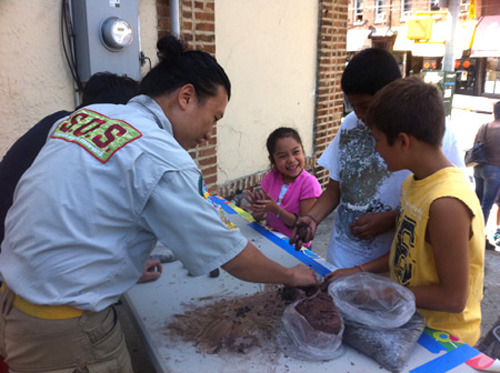Con Edison Immigrant Artist Program Newsletter, Issue No. 15
Featured Artist: Tattfoo Tan
IAP Program Officer Karen Demavivas interviews Tattfoo Tan.
IAP: You began as a painter and it was through color that you came into food. Beyond conventional matters of still life, how did this connection translate into activism?
TT: The switch from a studio to post studio practice was a simple transition for me. I saw a disconnect between art and the public. I wanted an art form that is more connected to life itself; an art form that resonates with the public; an art form that communicates a message that is not only intriguing and beautifying to look at, but spreads a bigger message that is beyond the wall of the gallery.
In the search to eat healthier myself, I created Nature Matching System, which is a colorful grid that was inspired by the skin colors of fruits and vegetables. They get their colors from phytonutrients, which are compounds that play key roles in health and reduce the risk of heart disease and cancer. This project was manifested as two murals in DUMBO, Brooklyn and Port Authority Bus Terminal in Manhattan. A free table mat was distributed to remind users to take their daily dose of color as they sit at the table for their daily meal. Now that all the table mats have been distributed, I have a screensaver of these colors to download from my website, which continues the above efforts.
IAP: Where you live on Staten Island has the fastest growing population among the five boroughs with a recent influx of a diversity of immigrants. Can you share how your work has engaged with the concerns of these newcomers?
TT: In general, Staten Island is often neglected in policy dialogue, conferences and events due in part to its geography, low overall population density, limited public transit system, and unfamiliar neighborhood characteristics. Thus, public programs and initiatives that might apply to other New York City neighborhoods are rarely extended to this borough. Compared to the rest of the City, the borough offers less social services and outreach to recent immigrants and low income families. Some consistently voiced concerns are a lack of youth programming and activities.
My work engages with the borough’s low income neighborhoods of St. George, Stapleton and Clifton/Park Hill. A recent influx of Hispanic, West African, Eastern European, Caribbean and Middle Eastern immigrants to these neighborhoods has both complicated and diversified the food landscape. For instance, while ethnic food stores proliferate, access to quality and affordable produce remains a concern. The neighborhoods of Stapleton and Park Hill are served by only a small number of food retailers and supermarkets that are particularly difficult to access on a regular basis, which negatively impacts the food purchasing habits of residents. Citizens rely primarily on public buses with limited routes and schedules. Additionally, there is only one Greenmarket serving these neighborhoods and the entire borough of half a million people.
These immigrants’ lack of access to good quality, healthy food is linked to the global crisis of industrial food production and distribution, which in turn, negatively impacts health. The economy is linked to the dependency of agro-business on oil and pharmaceuticals for the cheap production of food-like substances. The food industry uses more fossil fuel than any other sector of the economy. Contributing to the fossil fuel costs of the food system are: gas-powered farming equipment; chemical fertilizers made from natural gas; pesticides made from petroleum; gas-powered food processing machines; oil based packaging materials; and refrigerated transportation.
Our access to food directly impacts our health with healthcare quality declining and insurance costs escalating. Chronic disease due to the subsidized production of corn and soy products has needlessly been on the rise in our children for years, and has put a strain on our medical system. We need education regarding the real price of sustainable, healthy food. Our food system is at a critical point: we either reconnect to local resources, or we risk the health of ourselves, our communities, and the land. In response to the scare of tainted food supplies, our food production and delivery systems need to be re-examined and overhauled.
I engage immigrant communities through my project Sustainable. Organic. Stewardship. or S.O.S. It is a multi-faceted and year-long horticulture and cultivation project that includes social, cultural and artistic practices. Activities include panels, workshops, and tours. By acknowledging the shortage of food on a global scale, we look at how we eat, what we eat and how we can grow our own food. We seek to understand the origin and politics of food and labor. Through this project, we search, relearn and revive the lost knowledge of natural apothecaries, herbalism and foraging.
IAP: You are now working with a local laundromat in your neighborhood as part of your residency at the Laundromat Project. What participatory activities have you carried out so far?
TT: Every other Saturday from June to August this summer, I have been holding workshops at Victory Laundromat as a way to provide green alternatives and create change in my neighborhood on Staten Island. There are many immigrants from the West Indies (such as Trinidad) and Latin America here. I’ve engaged my neighbors in how to compost, raise egg-laying chickens, exchange organic seeds, and recycle plastic bottles as planters for their flowers and other plants. I’ve also led a bike tour through the area’s community gardens. This week, I’m showing people how to make seed balls out of a mix of organic seeds, dirt, clay and water. They end up looking like little chocolate truffles which you can throw into any lot or garden where they flourish into a diversity of flowers.
IAP: What were your neighbors’ reactions?
TT: People’s reactions have been positive and spontaneous. They get into the process, especially children who really have a lot of fun with it. In the composting workshop, they really loved the worms. I just want to plant green seeds in people’s consciousness so they know that they have the power to green up the neighborhood. I also want to provide them with tools to make greener choices in their lives.
IAP: As an immigrant among immigrants in your neighborhood here on Staten Island, how do you find living here and how do people treat you?
TT: It’s very diverse, which is one of the reasons I wanted to live on this part of the Island. There are a variety of ethnic foods here: Jamaican, Trinidadian, Polish, Mexican, and Sri Lankan to name a few. I am very open to trying different kinds. I also appreciate the diversity of languages you hear in this area. As for how people treat me, well, it’s New York, everyone pretty much comes from everywhere else. People just embrace you.
IAP: You’ve collaborated with many artists who have a similar sensibility to your work. In what ways would you like to engage more with food activists outside the art world?
TT: As far as collaborating with artists, we recently hosted a roundtable conversation about urban gardening at Arario Gallery on July 22, 2010. These meet-ups usually result in more collaborations with all parties involved. It forms a rhizomatic network of like-minded advocates.
When it comes to engaging food activists outside the art world, I find it’s more successful when they reach out to me and we can then figure out how to collaborate and help each other. The challenge is that we are all busy in our own kinds of duties. If food activists feel that a project needs an artistic view and they reach out to me, then great; otherwise, it just doesn’t click in some sense. It’s about needs; we all have certain skills that need to mesh.
IAP: What are your upcoming projects?
TT: I have been paying attention to bicycles around me when I’m walking about in New York. Last year, I saw a bike repair vendor in the Bronx near East Tremont Avenue and today I saw another one on Houston Street and 2nd Avenue. Bike culture is growing; can this small industry grow? It seems like the mobile repair shop is to serve those who are at the poverty line. This idea peaks my interest to investigate further into the cargo capability of a bicycle and how this may help in finding one’s livelihood. In India, there are vendors that use a bicycle to make a difference in their lives. Velocommerce is all about the mobility of property and it challenges notions of ownership and private capital. It is special because it exists at the intersection of entrepreneurship, mobility, sustainability, grassroots innovation, cultures, and local, decentralized economies. I am trying to figure out how I can adapt this concept in my art practice. How about becoming a GREENwala (i.e. a green vendor)?
I will be debuting my S.O.S. Mobile Classroom project at Farm City Fair on September 12th, 2010. It consists of a multi-usage cargo bicycle, which acts as a mobile classroom with green education tools when parked in the street or doing a workshop in a school or community event. It will be a catalyst for an interesting green conversation and spreading the message. This mobile classroom will engage visitors by doing workshops and providing a real to life scale model of what a mobile garden and a compost bin would be by hauling all the necessary equipment along.
In September, I am also scheduled to finish my public art project S.O.S. Pledge, which is commissioned by Percent for Art Program, Department of Cultural Affairs, City of New York and School Construction Authority. S.O.S. Pledge is an appropriation of the Pledge of Allegiance with a green mission. The gold-painted text is etched on Carrara Venatino Marble mural that is 10 feet high and 27 feet 9 inches wide. This work will call upon young students to be green stewards when they attend school every day. It provides an understanding of what we can do and change in our own lives: each of our individual actions are small, but our collective impact is big.
IAP: What are some ways that the public can find out and engage more with the intersection of art and food activism?
TT: They could always subscribe to my email blast and come to an event and network.





